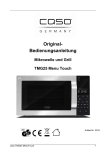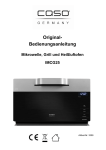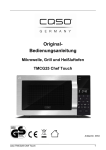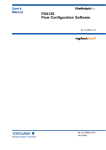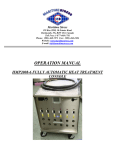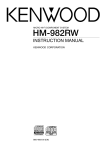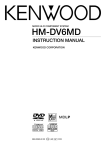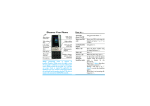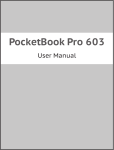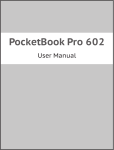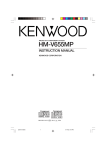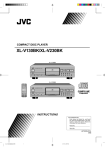Download Kenwood HD-7 User's Manual
Transcript
MICRO HI-FI COMPONENT SYSTEM
HD-7
INSTRUCTION MANUAL
KENWOOD CORPORATION
B60-5276-08 00 C
(K, T) OC 0204
2
Before applying power
HD-7/EN
Caution : Read this page carefully to ensure safe operation.
Units are designed for operation as follows.
U.S.A. and Canada ............................. AC 120 V only
Europe and U.K.................................. AC 230 V only
Preparation
For the United Kingdom
Factory fitted moulded mains plug
1. The mains plug contains a fuse. For replacement,
use only a 3-Amp ASTA-approved (BS1362) fuse.
2. The fuse cover must be refitted when replacing the
fuse in the moulded plug.
3. Do not cut off the mains plug from this equipment.
If the plug fitted is not suitable for the power points
in your home or the cable is too short to reach a
power point, then obtain an appropriate safety approved extension lead or adapter, or consult your
dealer.
If nonetheless the mains plug is cut off, remove the
fuse and dispose of the plug immediately, to avoid a
possible shock hazard by inadvertent connection to
the mains supply.
IMPORTANT : The wires in the mains lead are coloured
in accordance with the following code:
Blue : Neutral
Brown : Live
Do not connect those leads to the earth terminal of a
three-pin plug.
Safety precautions
WARNING : TO PREVENT FIRE OR ELECTRIC SHOCK, DO NOT EXPOSE THIS APPLIANCE TO RAIN OR MOISTURE.
CAUTION
RISK OF ELECTRIC SHOCK
DO NOT OPEN
CAUTION: TO REDUCE THE RISK OF ELECTRIC SHOCK, DO NOT
REMOVE COVER (OR BACK). NO USER-SERVICEABLE PARTS INSIDE. REFER SERVICING TO QUALIFIED SERVICE PERSONNEL.
THE LIGHTNING FLASH WITH ARROWHEAD SYMBOL, WITHIN AN EQUILATERAL TRIANGLE, IS INTENDED TO ALERT THE USER TO THE PRESENCE OF UNINSULATED "DANGEROUS VOLTAGE"
WITHIN THE PRODUCT’S ENCLOSURE THAT MAY BE OF SUFFICIENT MAGNITUDE TO CONSTITUTE
A RISK OF ELECTRIC SHOCK TO PERSONS.
THE EXCLAMATION POINT WITHIN AN EQUILATERAL TRIANGLE IS INTENDED TO ALERT THE
USER TO THE PRESENCE OF IMPORTANT OPERATING AND MAINTENANCE (SERVICING) INSTRUCTIONS IN THE LITERATURE ACCOMPANYING THE APPLIANCE.
CLASS 1
LASER PRODUCT
The marking of this product has been classified as Class 1. It means
that there is no danger of hazardous radiation outside the product.
Location: Back panel
Before applying power
3
HD-7/EN
Special features
Playback of CD-R/RW discs
recorded on a CD recorder.
"Linear T.R.A.I.T." (for Europe and U.K.), "K-STAT" (for USA)
power transistors
Kenwood's amplifiers now feature Linear T.R.A.I.T., the world's first power transistor with
built-in temperature detection and compensation circuitry. This advanced technology assures minimal distortion across all frequencies and gives an excellent three-dimensional
sonic image.
High-performance 24-bit D.R.I.V.E. II
Kenwood's innovative high-resolution 24-bit D.R.I.V.E. II technology features two types
of low pass filter that removes quantization distortion.
The result is an exceptionally pure and detailed sound from the loudest notes to the most
subtle of harmonics.
Preparation
The CD player is capable of playing both CD-R and CD-RW music discs, which have been
4
Before applying power
HD-7/EN
Accessories
Unpacking
Unpack the unit carefully and make sure that all the accessories are present.
FM indoor antenna (1)
Remote control unit (1)
Batteries (R6/AA) (2)
Preparation
AM loop antenna (1)
Speaker cords (2)
(provided in the speaker package)
If any accessories are missing, or if the unit is damaged or fails to operate, notify your dealer immediately. If the unit
was shipped to you directly, notify your shipper immediately. Kenwood recommends that you retain the original carton
and packing materials in case you need to move or ship the unit in the future.
Keep this manual handy for future reference.
For the U.S.A.
For the U.S.A.
FCC WARNING
CAUTION
This equipment may generate or use radio frequency
energy. Changes or modifications to this equipment
may cause harmful interference unless the modifications are expressly approved in the instruction manual.
The user could lose the authority to operate this equipment if an unauthorized change or modification is
made.
Use of controls or adjustments or performance of procedures other than those specified herein may result in
hazardous radiation exposure.
NOTE:
This equipment has been tested and found to comply
with the limits for a Class B digital device, pursuant to
Part 15 of the FCC Rules. These limits are designed to
provide reasonable protection against harmful interference in a residential installation. This equipment may
cause harmful interference to radio communications, if
it is not installed and used in accordance with the instructions. However, there is no guarantee that interference will not occur in a particular installation. If this
equipment does cause harmful interference to radio or
television reception, which can be determined by turning the equipment off and on, the user is encouraged to
try to correct the interference by one or more of the
following measures:
– Reorient or relocate the receiving antenna.
– Increase the separation between the equipment
and receiver.
– Connect the equipment into an outlet on a circuit
different from that to which the receiver is connected.
– Consult the dealer or an experienced radio / TV
technician for help.
In compliance with Federal Regulations, the following are
reproductions of labels on, or inside the product relating
to laser product safety.
KENWOOD CORPORATION
2967-3, ISHIKAWA-MACHI,
HACHIOJI-SHI,
TOKYO, JAPAN
KENWOOD CORP. CERTIFIES THIS EQUIPMENT
CONFORMS TO DHHS REGULATIONS NO. 21
CFR 1040.10, CHAPTER 1, SUBCHAPTER J.
Location: Back Panel
Before applying power
5
HD-7/EN
Contents
Caution : Read the pages marked
carefully to ensure safe operation.
Preparation section
Application section
Various CD playback features ...............................30
Safety precautions ................................................. 2
Special features ........................................................... 3
Accessories .................................................................. 4
Contents ......................................................................... 5
Listening to the desired sequence (program
playback) .............................................................. 30
Repeated playback .................................................... 32
Listening in random order (random mode) ............ 33
Setting auto power save (A.P.S.) ............................. 34
Adjusting the brightness of the display part
(DIMMER) .............................................................. 34
IMPORTANT SAFEGUARDS...................................... 6
System connections ..................................................8
Connection of accessory antennas ......................... 8
Connection of FM outdoor antenna ......................... 9
Connection of the speaker system ........................... 9
Connection of a subwoofer
(sold separately) ................................................... 10
Connection of a cassette deck
(sold separately) ................................................... 10
Connection to an external source
(audio equipment) ................................................ 11
Controls and indicators...........................................12
Main unit ...................................................................... 12
Display.......................................................................... 13
Remote control unit ................................................... 14
Clock adjustment .....................................................35
Timer operation ........................................................36
Sleep timer (SLEEP) ................................................... 36
Setting the timer program (PROG. TIMER) ............. 37
Knowledge sections
Important Items .........................................................40
Maintenance ............................................................... 40
Reference .................................................................... 40
In case of difficulty .................................................. 42
Specifications ...........................................................44
Operation of remote control unit ........................... 15
Basic section
Basic use method..................................................... 16
Adjusting the tone ...................................................... 18
Playback of CD .........................................................20
Receiving broadcast station ..................................22
Channel space setting ............................................... 23
RDS (Radio Data System) (For U.K. and Europe) ........ 25
Listening to an AUX/TAPE input soarce............... 28
As an ENERGY STAR® Partner,
Kenwood Corporation has determined that this products meets the
ENERGY STAR® guidelines for
energy efficiency. This product can save energy.
Saving energy reduces air pollution and lowers utility
bills.
Preparation
Before applying power ........................................2
6
IMPORTANT SAFEGUARDS
Caution :
Read this page carefully to ensure
safe operation.
HD-7/EN
Preparation
Please read all of the safety and operating instructions before
operating this appliance. Adhere to all warnings on the appliance
and in the instruction manual. Follow all the safety and operating
instructions. These safety and operating instructions should be
retained for future reference.
1. Power sources – The appliance should be connected to a
power supply only of the type described in the instruction
manual or as marked on the appliance. If you are not sure of
the type of power supply to your home, consult your appliance
dealer or local power company. For appliances intended to
operate from battery power, or other sources, refer to the
instruction manual.
2. Power-cord protection – Power-supply cords should be
routed so that they are not likely to be walked on or pinched by
items placed upon or against them, pay particular attention to
cords at plugs, convenience receptacles, and the point where
they exit from the appliance.
6. Temperature – The appliance may not function properly if
used at extremely low, or freezing temperatures. The ideal
ambient temperature is above +5°C (41°F).
7. Heat – The appliance should be situated away from heat
sources such as radiators, heat registers, stoves, or other
appliances (including amplifiers) that produce heat. Do not
place a flaming object, such as a candle or lantern, on or near
the appliance.
8. Electric shock – Care should be taken so that objects do not
fall and liquid is not spilled into the enclosure through openings.
If a metal objects, such as a hair pin or a needle, comes into
contact with the inside of this appliance, a dangerous electric
shock may result. For families with children, never permit
children to put anything, especially metal, inside this appliance.
Never pull or stretch
the cord.
3. CAUTION – Polarization – This appliance may be equipped
with a polarized alternating-current line plug (a plug having one
blade wider than the other). This plug will fit into the power
outlet only one way. This is a safety feature. If you are unable
to insert the plug fully into the outlet, try reversing the plug. If
the plug should still fail to fit, contact your electrician to replace
your obsolete outlet. Do not defeat the safety purpose of the
polarized plug.
4. Ventilation – Slots and openings in the cabinet are provided
for ventilation and to ensure reliable operation of the appliance
and to protect it from overheating, and these openings must
not be blocked or covered. The appliance should be situated so
that its location or position does not interfere with its proper
ventilation.
To maintain good ventilation, do not put records or a table-cloth
on the appliance. Place the appliance at least 10 cm away from
the walls.
Do not use the appliance on a bed, sofa, rug or similar surface
that may block the ventilation openings. This appliance should
not be placed in a built-in installation such as a bookcase or rack
unless proper ventilation is provided or the manufacturer’s
instructions have been adhered to.
5. Water and moisture – The appliance shall not be exposed to
dripping and splashing - for example, near a bathtub, washbowl,
kitchen sink, laundry tub, in a wet basement, or near a
swimming pool, etc. Do not place an object containing liquid,
such as a flower vase, on the appliance.
9. Enclosure removal – Never remove the enclosure. If the
internal parts are touched accidentally, a serious electric shock
might occur.
10. Magnetic fields – Keep the appliance away from sources of
magnetic fields such as TV sets, speaker systems, radios,
motorized toys or magnetized objects.
11. Cleaning – Unplug this appliance from the wall outlet before
cleaning. Do not use volatile solvents such as alcohol, paint
thinner, gasoline, or benzine, etc. to clean the cabinet. Use a
clean dry cloth.
12. Accessories – Do not place this appliance on an unstable cart,
stand, tripod, bracket, or table. The appliance may fall, causing
serious injury to a child or adult, and serious damage to the
appliance. Use only with a cart, stand, tripod, bracket, or table
recommended by the manufacturer, or sold with the appliance.
Any mounting of the appliance should follow the manufacturer’s
instructions, and should use a mounting accessory
recommended by the manufacturer. An appliance and cart
combination should be moved with care. Quick stops, excessive
force, and uneven surfaces may cause the appliance and cart
combination to overturn.
Caution :
Read this page carefully to ensure safe operation.
7
HD-7/EN
18.Power lines – An outside antenna system should not be
located in the vicinity of overhead power lines or other electric
light or power circuits, or where it can fall into such power lines
or circuits. When installing an outside antenna system, extreme
care should be taken to keep from touching such power lines
or circuits as contact with them might be fatal.
14.Abnormal smell – If an abnormal smell or smoke is
detected, immediately turn the power OFF and unplug
the appliance from the wall outlet. Contact your dealer or
nearest service center.
19.AC outlets – Do not connect other audio equipment
with a power consumption larger than that specified to
the AC outlet on the rear panel. Never connect other
electrical appliances, such as an iron or toaster, to it to
prevent fire or electric shock.
15.Damage requiring service – The appliance should be
serviced by qualified service personnel when:
A. The power-supply cord or the plug has been damaged.
B. Objects have fallen, or liquid has been spilled into
the appliance.
C. The appliance has been exposed to rain or water.
D. The appliance does not appear to operate normally
by following the instruction manual. Adjust only those controls
that are covered by the instruction manual as an improper
adjustment of other controls may result in damage and will
often require extensive work by a qualified technician to
restore the appliance to its normal operation.
E. The appliance has been dropped, or the enclosure
damaged.
F. The appliance exhibits a marked change in performance.
16.Servicing – The user should not attempt to service the
appliance beyond that described in the instruction
manual. All other servicing should be referred to qualified
service personnel.
20. Overloading – Do not overload wall outlets, extension cords,
or integral convenience receptacles as this can result in a risk
of fire or electric shock.
21. Attachment – Do not use attachments not recommended by
the appliance manufacturer as they may cause hazards.
22. Replacement parts – When replacement parts are required,
be sure the service technician has used replacement parts
specified by the manufacturer or have the same characteristics
as the original parts. Unauthorized substitutions may result in
fire, electric shock, or other hazards.
23. Safety check – Upon completion of any service or repairs to
this appliance, ask the service technician to perform safety
checks to determine that the appliance is in proper operating
condition.
17.Outdoor antenna grounding – If an outside antenna is
connected to the appliance, be sure the antenna system
is grounded so as to provide some protection against
voltage surges and built up static charges. Article 810 of
the National Electrical Code ANSI/NFPA 70, provides
information with respect to proper grounding of the
mast and supporting structure, grounding of the lead-in
wire to an antenna discharge unit, size of grounding
conductors, location of antenna discharge unit,
connection to grounding electrodes, and requirements
for the grounding electrode. See Figure.
EXAMPLE OF ANTENNA GROUNDING AS PER NATIONAL
ELECTRICAL CODE
ANTENNA
LEAD IN WIRE
GROUND
CLAMPS
ANTENNA
DISCHARGE UNIT
(NEC SECTION 810-20)
ELECTRIC
SERVICE
EQUIPMENT
GROUNDING CONDUCTORS
(NEC SECTION 810-21)
GROUND CLAMP
POWER SERVICE GROUNDING
ELECTRODE SYSTEM
(NEC ART 250, PART H)
NEC – NATIONAL ELECTRICAL CODE
Notes:
1. Item 3 is not required except for grounded or polarized equipment.
2. Item 17 and 18 are not required except for units provided with antenna
terminals.
3. Item 17 complies with UL in the U.S.A.
Preparation
13.Lightning – For added protection for this appliance during a
lightning storm, or when it is left unattended and unused for
long periods of time, unplug it from the wall outlet and
disconnect the antenna or cable system. This will prevent
damage to the appliance due to lightning and power-line
surges.
8
System connections
HD-7/EN
Make connections as shown below.
When connecting the related system components, refer also to the instruction manuals of the related components.
CAUTION
CAUTION
Do not plug in the power lead until all connections are
completed.
Malfunction of microcomputer
Basic
If operation is not possible or erroneous display
appears even though all connections have been
made properly, reset the microcomputer by
referring to "In case of difficulty". w
Be sure to adhere followings. Or proper ventilation
will be blocked causing damage or fire hazard.
÷ Do not place any objects impairing heat radiation
onto the top of the unit.
÷ Leave some space around the unit (from the largest outside dimension including projection) equal
to or greater than, shown below.
Top panel : 50 cm
Back panel : 10 cm
Connection of accessory antennas
FM indoor antenna
The supplied antenna is for temporary indoor use only. For stable signal
reception, we recommend to use an outdoor antenna. Remove the indoor antenna if you connect to an outdoor antenna.
1 Connect the antenna to the antenna terminal.
2 Locate the position providing good reception condition.
3 Fix the antenna.
1
2
3
AM loop antenna
The supplied antenna is for indoor use. Place it as
far as possible from the main system, TV set,
speaker cords and power cord, and set it to a direction which provides the best reception.
System connection
9
HD-7/EN
Connection of FM outdoor antenna (sold separately)
Antenna adaptor
(Commercially
Available Parts)
FM outdoor antenna
Lead the 75 Ω coaxial cable connected to
the FM outdoor antenna into the room
and connect it to the FM 75 Ω terminal.
Please remove the indoor antenna after
an outdoor antenna has been installed.
Basic
Connection of the speaker system
Speaker (Right)
Speaker (Left)
1
−
2
3
POWER cord
+
−
+
TO WALL AC
OUTLET
Main unit
Speaker cord
Speaker cord
÷ Never short-circuit the + and – speaker cords.
÷ If the left and right speakers are connected inversely or if the speaker cords are connected with reversed polarity,
the sound becomes unnatural with ambiguous acoustic image positioning. Be sure to connect the speakers and
speaker cords correctly.
10
System connection
HD-7/EN
Connection of a subwoofer (sold separately)
A subwoofer provides powerful playback of the very low range. It can be used with all types of playback.
Subwoofer
Basic
KENWOOD
Connection of a cassette deck (sold separately)
Connect a separately sold cassette deck with the accessory audio cord to the terminals TAPE PLAY IN
and REC OUT at the rear of this unit. Please refer also to the operation instructions supplied with the
cassette deck.
To RECORD IN
cassette deck
2
Audio code
3
0
7
1
¡
8
¶
Audio code
To PLAY OUT
System connection
11
HD-7/EN
Connection to an external source (audio equipment)
In case of analog connection
You can use the input terminal AUX at the rear of this unit to connect a video deck or a record player (P110) (sold separately) with built-in RIAA equalizer amplifier.
video deck or
a record player
Audio code
In case of digital connection
You can use the digital output terminal OPTICAL at the rear of this unit.
Square optical
connector plug
MD recorder etc.
Basic
Audio OUTPUT
12
Controls and indicators
HD-7/EN
Main unit
8
Basic
1
2
9
0
3
!
4
5
6
@
#
$
7
%
^
&
1 standby/timer indicator
Standby status (power OFF): Red
0 Display panel
! stop 7 key
Press to stop a disc.
Timer standby status (power OFF): Green
Energized (power ON): Not lit
2
key
Press to set the unit to On or Standby.
3 sound key
Used to switch the sound.
4 1 TUNING ¡ keys
CD :
^
&
¡
Used to fast-forward or fast-reverse the played
audio.
TUNER :
¢
Used to select a radio station.
5 Remote sensor
%
This window receives signals from the remote
control unit.
6 CD tray
)
7 Headphone jack
^
Connect headphone with a stereo mini-plug (optionally available).
8 menu key
&
Used for application operations for each source.
set key
&
Used to confirm a function selected in the
menu.
9 volume/multi control knob
^&
Used for volume adjustment and to select items
in the setting menus.
)
When this is pressed in standby mode, the
present time is displayed for 5 seconds.
4 p.call ¢ key
CD : skip CD tracks
TUNER : select a preset radio station
@ Input selection keys
AUX/TAPE
¡
™
•
Selection of AUX (externally connected equipment) or tape.
TUNER/BAND
™
Used to switch the broadcasting band (AM or
FM) when listening to the radio.
CD 6
)
Used to select CD for playback and for pausing.
# source direct key
&
Key for listening with high sound quality by
eliminating additional circuits as far as possible.
$ 0 key
To load or eject a CD.
)
% repeat key
Press for setting repeated playback.
¤
^ random key
‹
Press for setting playback of tracks in a random
orde.
& display key
¡
The display contents of the display are switched.
Controls and indicators
13
HD-7/EN
Display
1 23 4 5 6 7
REMAIN
^
TOTAL AUTO
FM
AM
PM
1
8
90
TUNED STEREO
R .D .S PTY
kHz
MHz
#
! @
L
R
1 2
A.P.S.
30 10 5
3
PGM
RANDOM
MUTE
N.B. 1 2
S.DIRECT
%
1
0 (–dB)
2 4
DIGITAL
$
Basic
1 Playback indication
2 Playback pause indication
3 AM/FM (reception band) indication
AM/PM (morning/afternoon) indication
4 REMAIN (remaining time) indication
5 Numerical display of frequency, time, track
No., program No., etc.
6 TOTAL(total recording time) indication
7 AUTO (auto tuning) indication
8 TUNED (radio broadcast tuned) indication
9 STEREO (stereo broadcast reception)
indication
0 R·D·S (Radio Data System) indication,
PTY (Program Type Identification) indication
(For UK and Europe)
!
(sleep timer) indication
1
(timer 1) indication
2
(timer 2) indication
@ A.P.S. indication
Indication of automatic power saving status.
# Level indication
$ Character information display
Character information like the name of the received radio station (at the time of FM auto preset), CD title, etc. is displayed.
% PGM indication
Indication at the time of program playback.
RANDOM indication
Indication at the time of random playback.
MUTE indication
Indication at the time of mute (no sound).
N.B.1/N.B.2 indication
Indication when the N.B. (natural bass) function
is selected.
S.DIRECT indication
Indication when the source direct function is
ON.
^ Repeat mode indication
1 : Indication of one track repeat.
: Indication of all repeat
14
Controls and indicators
HD-7/EN
Remote control unit
The keys on the remote control unit with the same names as on
the main unit have the same function as the keys on the main unit.
POWER
1
2
1
2
3
4
5
6
7
DISPLAY
8
9
0
+10
TIME
CLEAR
8
7 TIMER key
·
Used for execution and cancellation of the various timers.
8 POWER key
Press to set the unit to On or Standby.
SET
ENTER
9
9 SET key
º
Used for programmsetting. At the time of
standby, used for clock display.
TUNER/BAND
3
CD
6
AUX
/TAPE
4
4
5
6
7
P.CALL ¢
1 TUNING ¡
DOWN
UP
0
AUTO/MONO
REPEAT
RANDOM
/PTY
P.MODE
/RDS DISP.
TIMER
SOUND
MUTE
DOWN
VOLUME
Basic
SLEEP
7 STOP
UP
^
ENTER key
Used for confirmation of setting.
£
0 7 STOP/AUTO/MONO key
!
@
#
CD :
Press to stop a disc.
)
TUNER :
Used to switch AUTO tuning or MANUAL tuning (Monaural reception)
¢
Standby mode :
When this is pressed in standby mode, the
present time is displayed for 5 seconds.
Infrared ray system
Model : RC-F0701 (For U.S.A. and Canada)
! RANDOM/PTY key (For Europe and U.K.)
CD :
‹
Press for setting playback of tracks in a random order.
: RC-F0701E (For UK and Europe)
1 Numeric keys
¡¢
Used to select a CD track number or recall a preset station of the tuner.
TUNER :
Used at the time of PTY reception.
§
¡
RANDOM key (For U.S.A. and Canada) ‹
Press for setting playback of tracks in a random
order.
TIME key
Used for time display switching.
¡
P.MODE/RDS DISP. key (For Europe and U.K.)
CLEAR key
Used to delete a program.
⁄
CD :
º
Press to program tracks in the desired sequence.
2 DISPLAY key
Used for display switching.
3 Basic operation keys (input selectors, play/
pause)
CD 6 key
)
TUNER/BAND key
™
AUX/TAPE key
•
4 4 P.CALL ¢ keys
¡™
5 1 TUNING ¡ keys
¡¢
6 SLEEP key
Press to set the sleep timer
REPEAT key
Press for setting repeated playback.
fl
¤
TUNER :
Used at the time of RDS reception.
¶
P.MODE key (For U.S.A. and Canada)
º
Press to program tracks in the desired sequence.
@ SOUND key
Press to switch the sound effect.
MUTE key
Press to mute the audio temporarily.
# VOLUME keys
Press to adjust the volume.
&
&
^
Operation of remote control unit
15
HD-7/EN
Loading batteries
1 Remove the cover.
2 Insert batteries.
3 Close the cover.
÷ Insert two R6 ("AA"-size) batteries
following the polarity indications.
Operation
Operating range (approx.)
After plugging the power cord of this unit,
Basic
press the POWER ( ) key of the remote control unit to turn the system ON. When the system is turned ON, press the key of the function
to be operated.
Remote sensor
6m
30˚
30˚
÷ When pressing more than one remote control
keys successively, press the keys securely by
leaving an interval of 1 second or more between
keys.
÷ The provided batteries are intended for use in operation checking, and their service life may be short.
÷ When the remote controllable distance becomes short, replace both of the batteries with new ones.
÷ If direct sunlight or the light of a high-frequency fluorescent lamp (inverter type, etc.) is incident to the remote
sensor, malfunction may occur. In such a case, change the installation position to avoid malfunction.
16
Basic use method
HD-7/EN
POWER
1
2
3
4
5
6
7
DISPLAY
8
9
0
+10
TIME
CLEAR
ENTER
TUNER/BAND
CD
6
AUX
/TAPE
4
SOUND
P.CALL ¢
7 STOP
1 TUNING ¡
DOWN
UP
AUTO/MONO
SLEEP
REPEAT
RANDOM
TIMER
SOUND
DOWN
VOLUME
1
SET
P.MODE
MUTE
UP
2
3
1
sound
MUTE
2
3
II
source
direct
phones
1 Power ON (OFF)
Basic
When the power is ON and the
comes OFF (standby).
key is pressed, the power be-
It takes a little time from power OFF operation until the power is
switched off.
÷ For about five seconds after power ON, mute (no sound) status is
applied for circuit protection.
One-touch operation function
When one of the following keys is operated in power OFF (standby) condition, the power will be switched on, the source will be selected, and
playback will start in case of CD.
CD6 key, TUNER/BAND key, AUX/TAPE key.
2. Select the source to be listened to.
CD
TUNER
AUX/TAPE
)
™
¢
L
R
30 10 5
3
1
0 (–dB)
DIGITAL
* The source can also be selected by pressing TUNER/BAND, CD 6, or
AUX/TAPE on the remote control. (Playback will start automatically
when CD 6 is pressed.)
Decrease
Increase
3. Adjust the volume.
÷ Rapid turning produces a
large change in volume. (AI
VOLUME function)
L
R
30 10 5
3
1
0 (–dB)
DIGITAL
÷ A guide value (0 to MAX) is shown on the display.
Listening through headphone
÷ Insert the headphone plug into the headphone jack.
÷ The sound from all speakers are cut off.
÷ Turn the volume/multi control knob to adjust the volume.
÷ Lower the volume before you connect or disconnect plugs.
÷ Headphone with a stereo mini plug can be connected.
Basic use method
17
HD-7/EN
Muting the sound temporarily
Remote control unit only
MUTE
MUTE
÷ Press again to resume the original volume.
÷ This is also canceled when the volume is changed.
Blinks
Adjust the left/right volume balance
Main unit only
1 Select "BALANCE" as follows.
1 Press the "menu" key.
1
2 Select "BALANCE" with the
"volume/multi control" knob.
When the "volume/multi control "
knob is turned, switching is done
as follows.
3
"AUX INPUT ?"
"TONE ?"
"BALANCE ?"
"TIME ADJUST ?"
"TIMER SET ?"
"A.P.S. SET ?"
"DIMMER ?"
Return to the original status is
made when no operation is performed within 20 seconds.
2 Press the "set" key.
2 Adjust the left/right volume balance with
the "volume/multi" control knob.
The right volume
decreases.
The left volume
decreases.
The sound from CD or another source can be heard
as faithful as possible to the original sound by not
passing it though the sound adjustment circuits
of this unit.
Main unit only
1 Press the "sound" key repeatedly to select
"S.DIRECT".
Each press switches the modes as follows.
"N.B.1"
"N.B.2"
* "TONE 1"
* "TONE 2"
* "TONE 3"
"SOURCE DIRECT"
"SOUND MODE OFF"
S.DIRECT
Lit
* "TONE 1(2,3)" is not displayed when "BASS"
and "TREBLE" both are set to "0".
÷ When source direct is selected, N.B1, N.B2,
and TONE1, TONE2, TONE3 are cancelled.
÷ To return to normal mode, press the "sound"
key repeatedly to select "SOUND MODE
OFF".
Direct selection of the source direct function
Main unit only
S.DIRECT
2 Press the "set" key.
Lit
÷ To return to normal mode,
press the "sound" key repeatedly to select "SOUND
MODE OFF".
Basic
2
Listening to the original sound of the
source (source direct)
18
Basic use method
HD-7/EN
Adjusting the tone
TONE CONTROL
The low range (BASS) and the high range (TREBLE) each can be set to a desired level.
Three types of tone control can be set in advance.
Listening with use of TONE CONTROL
TONE CONTROL setting
Select and set the desired tone control setting set
in advance.
Main unit only
1 Select "TONE ?" as follows.
1
Main unit only
1 Press the "menu" key.
2 Select "TONE ?" with the
"volume/multi control"
knob.
1 Press the "sound" key repeatedly to select
"TONE 1", "TONE 2" or "TONE 3".
Each press switches the modes as follows.
2
"N.B.1"
"N.B.2"
* "TONE 1"
* "TONE 2"
* "TONE 3"
"SOURCE DIRECT"
"SOUND MODE OFF"
DIGITAL
Basic
3 Press the "set" key.
3
* "TONE 1(2,3)" is not displayed when
"BASS" and "TREBLE" both are set to "0".
2 Select "TONE 1 ?" (or 2, 3) with the "volume/multi control" knob and press the
"set" key.
÷ To return to normal mode, press the "sound"
key repeatedly to select "SOUND MODE
OFF".
N.B. circuit (natural bass)
NB1 : The low range will be emphasized.
NB2 : The low range will be emphasized still further.
3 Adjust the level for the low range (BASS)
with the volume/multi control knob and
press the "set" key.
L
R
30 10 5
3
1
Main unit only
1 Press the "sound" key repeatedly to select
"N.B.1" or "N.B.2".
0 (–dB)
Each press switches the modes as follows.
DIGITAL
Change is made in steps of 2
from -8 to +8.
4 Adjust the level for the high range (TREBLE)
with the volume/multi control knob and
press the "set" key.
L
R
30 10 5
3
1
0 (–dB)
DIGITAL
Change is made in steps of 2
from -8 to +8.
÷ When the setting has been completed, return to the original display is made after display of "COMPLETE".
"N.B.1"
"N.B.2"
* "TONE 1"
* "TONE 2"
* "TONE 3"
"SOURCE DIRECT"
"SOUND MODE OFF"
* "TONE 1(2,3)" is not displayed when
"BASS" and "TREBLE" both are set to "0".
÷ To return to normal mode, press the "sound"
key repeatedly to select "SOUND MODE
OFF".
Basic use method
19
HD-7/EN
Basic
20
Playback of CD
HD-7/EN
4 P.CALL ¢
CD6
set
POWER
DISPLAY
/CHARAC
4 P.CALL ¢
1 TUNING ¡
1
2
3
4
5
6
7
8
9
0
+10
DISPLAY
TIME
CLEAR
SET
ENTER
TUNER/BAND
CD
6
AUX
/TAPE
4
P.CALL ¢
7 STOP
1 TUNING ¡
DOWN
UP
AUTO/MONO
SLEEP
REPEAT
RANDOM
P.MODE
TIMER
SOUND
MUTE
DOWN
VOLUME
SET
2 CD6
7STOP
2
1
II
UP
stop7
1. Load a disc.
display
Label side
Basic
1 Open the CD tray.
2 Place a disc.
3 Close the CD tray.
÷ Always press the 0 key to close the
CD tray.
÷ Do not touch the played side of disc.
÷ Be sure to place a disc horizontally.
Placing it with an inclination will result
in malfunction.
Recess for
single CD (8 cm)
2. Start playback.
÷ After a few seconds, play
starts from track No.1.
Playback
indication
Elapsed time of
track being played
L
R
30 10 5
3
1
0 (–dB)
DIGITAL
Track No. being played
Level
indication
To stop playback
To pause playback
Lit
÷ Each press pauses and plays the CD
alternately.
Playback of CD
21
HD-7/EN
To fast forward and backward
Main unit
Skipping tracks
Remote control
Main unit
Remote control
4
TUNING ¡
DOWN
UP
1
tuning
÷ Press and hold one of the keys during playback. Normal playback resumes at the point
where the key is released.
Playback from desired track
Remote control unit only
P.CALL ¢
÷ The track in the direction of the key pressed
is skipped, and the selected track will be
played from the beginning.
÷ When the 4 key is pressed once during
playback, the track being played will be
played from the beginning.
÷ To skip further to a track located before the
current track, press the 4 key quickly.
Select the desired track No.
2
3
4
5
6
7
8
9
0
+10
Press the numeric keys as
shown below....
Basic
1
To select track No. 23
+10
:
+10
,
3
,
To select track No. 30
+10
:
+10
,
+10
,
0
,
In regard to display of the CD time
In regard to title display
Each time the "TIME/SPACE" key is pressed
during CD playback, the time display on the
display is switched.
When a disc conforming to CD TEXT is played
and the display key is pressed during CD
playback (or during stop), the character information recorded on the CD can be displayed
on the display. Each time the display key is
pressed, switching is done between the following items.
Remote control unit only
TIME
Main unit
1 Elapsed time of the track
: 1:23
2 Remaining time of the track
: REMAIN display 2:37
3 Total elapsed time of the disc
: TOTAL display 23:50
4 Total remaining time of the disc
:REMAIN TOTAL display 36:50
÷ Only 1 and 2 are displayed during random
playback and single track repeat.
÷ At the time of program playback, 4 becomes the display of the total time for the
programmed tracks.
Remote control
DISPLAY
Disc title *1
→Track No. → Track title *1
*1
The disc title is displayed during stop.
The track title is scrolled during playback.
22
Receiving broadcast station
HD-7/EN
4 P.CALL ¢
POWER
DISPLAY
/CHARAC
3
4 P.CALL ¢
1 TUNING ¡
1
2
3
4
5
6
7
8
9
0
+10
DISPLAY
TIME
CLEAR
SET
ENTER
TUNER/BAND
CD
6
AUX
/TAPE
4 P.CALL ¢
7 STOP
1 TUNING ¡
DOWN
UP
AUTO/MONO
SLEEP
REPEAT
RANDOM
TIMER
SOUND
DOWN
VOLUME
P.MODE
ENTER
1
AUTO/MONO
1
MUTE
II
3
UP
1 TUNING ¡
display
1. Select the tuner input.
Basic
Each press of the TUNER/band key switches the band as follows.
FM
AM
2. Preset a radio station in memory.
Collective presetting of stations
£
Follow the procedure in "Collective presetting of stations" to preset
automatically the tunable radio stations in your area.
÷ Once the stations are stored by auto presetting, you are not required
to repeat this procedure the next time you listen to radio. However
when you shift to another location whereby the broadcast station
frequencies are different, you will have to re-execute the presetting
of stations.
One-by-one presetting (Manual preset) ¢
A station can also be tuned even when it is not preset. For details,
read "Tuning to a non-preset radio station (Auto tuning, Manual
tuning)".
3. Tuning (Preset Call)
÷ If radio stations have already been stored with
auto presetting or manual
presetting, select a station
using the 4, ¢ key.
Each press of the same
key switches the preset
stations in sequence.
Tuned
indication
Stereo broadcast
Auto tuning
reception indication
indication
AUTO
TUNED STEREO
FM
L
R
30 10 5
3
1
0 (–dB)
MHz
DIGITAL
When ¢ is pressed : 1=2=3 ... 38=39=40=1...
When 4 is pressed : 40 = 39 = 38 ..... 3 = 2 = 1 = 40.....
÷ When a key is held depressed, preset stations will be skipped at an interval of about 0.5 second.
÷ To select a preset station from the remote, use the 4 P.CALL ¢ key
or numeric keys.
Receiving broadcast station
23
HD-7/EN
Collective presetting of stations
AUTO PRESET ........ For U.S.A. and Canada
AUTO MEMORY ..... For U.K. and Europe
Remote control unit only
1 Select the tuner input.
TUNER/BAND
2 Press the "ENTER" key for more than 2 seconds
AUTO
STEREO
FM
L
R
30 10 5
3
1
0 (–dB)
MHz
ENTER
Channel space setting
The space between radio channels has been set to the one that prevails in the area to which the system is shipped.
However, if the current channel space setting does not match the setting in the area where the system is to be
used, for instance when you move from area 1 or area 2 shown in the following table or vice versa, proper reception of AM/FM broadcasts cannot be expected. In this case, change the channel space setting in accordance with
your area by referring to the following table.
Main unit only
1 Select the tuner input.
Each press the "stop 7" key for more than 2 seconds switches the modes as follows.
1 FM 50 k
2 FM 100 k
2 Press the "stop 7" key for more than 2seconds.
÷ At FM 50 kHz, the corresponding AM frequency is
9 kHz.
At FM 100 kHz, the corresponding AM frequency
is 10 kHz.
Area
1
USA, Canada and South
American countries
2
Other countries
CHANNEL
Space Frequency
FM: 100 kHz
AM: 10 kHz
FM: 50 kHz
AM: 9 kHz
Basic
÷ A maximum of 40 stations of the band presently
being received will be preset.
÷ When there are many stations and the intended
station has not been preset, please also use
"One-by-one presetting (Manual preset)".
24
Receiving broadcast station
HD-7/EN
Tuning to a non-preset radio station (Auto tuning, Manual tuning)
Select the tuning mode according to the radio
wave receiving condition.
When the receiving condition is good:
AUTO mode
When it is poor due to weak radio waves:
MANUAL mode
1 Press the " 7 STOP (AUTO/MONO)" key
during TUNER input.
Main unit
Remote control
÷ In MANUAL mode, FM stations are received
in monaural.
7 STOP
AUTO/MONO
Basic
2 Tune a station.
1 TUNING ¡
DOWN
UP
tuning
Each press alternates the mode.
1 "AUTO"
: Stereo reception
2 "MANUAL" : Monaural reception
In AUTO mode :
The next preset station can be received automatically every time the TUNING (1 or ¡) key is
pressed.
In MANUAL mode :
Press the TUNING (1 or ¡) key repeatedly until
the desired station is received. The desired station
can also be received by holding the TUNING (1 or
¡) key depressed until its frequency is displayed.
One-by-one presetting (Manual preset)
Remote control unit only
1 Perform the procedure in "Tuning to a nonpreset radio station (Auto tuning, Manual
tuning)" to receive the station to be preset.
2 Press the ENTER key during reception.
ENTER
÷ A maximum of 40 stations of the band presently
being received will be preset.
3 Select one of the preset numbers from 1 to 40.
4
P.CALL ¢
or
1
2
3
4
5
6
7
8
9
0
+10
4 Press the ENTER key again.
(Repeat steps 1, 2, 3 and 4 to preset other
stations)
÷ If several stations are preset under the same number, the previous memory is replaced with the latest
memory contents.
RDS (Radio Data System) (For U.K. and Europe)
25
HD-7/EN
RDS is a system which transmits useful information (digital data) for FM broadcasts together with the broadcast signal. Tuners and receivers designed for RDS reception can extract the information from the broadcast signal for use with various functions such as automatic display of the station name.
This unit is equipped with the following functions utilizing RDS data :
PTY (Program Type Identification) Search :
§
The tuner automatically searches for a station which is
currently broadcasting a specified program type
(genre).
PS (Program Service Name) Display :
When an RDS broadcast is received, the station
name is automatically displayed.
FM
TUNED STEREO
R·D·S PTY
L
R
30 10 5
3
1
0 (–dB)
MHz
÷ Some functions may not be provided or be given
different names depending on countries or areas.
For reception of RDS stations, the auto memory function must be used to preset the stations. During
the auto memory function, the presetting sequence priority will be given to the RDS stations.
Basic
Before using RDS
26
RDS (Radio Data System) (For U.K. and Europe)
HD-7/EN
Searching for a desired program type (PTY search)
By specifying the type of program (genre) you want to listen to, the tuner automatically searches for a
station which is currently broadcasting a program of the specified type.
However, if a station is not preset by auto memory, "NO DATA" will light instead of the program (genre)
type and PTY search is not available.
Set the reception band to FM. Preset RDS stations with the auto memory function. ¢
1. Select the PTY search mode.
Lit
Remote control unit only
FM
TUNED STEREO
R·D·S PTY
L
R
30 10 5
3
1
0 (–dB)
MHz
RANDOM
/PTY
Basic
When an RDS broadcast is received, the program
type is shown on the display. If no PTY data is
available, or if the station is not an RDS station,
"NONE" is displayed.
2. Select the desired program type.
Use program type table on the right for your convenience.
Selection with the 4 or ¢ key.
Program type table
4, ¢ keys
4
DOWN
4
P.CALL ¢
UP
¢
Select while "PTY" is lit.
The desired program type can be selected
with the 4 or ¢ key from 29 types. Press
the key and release it when the desired type is
displayed.
Program Type Name
Pop Music
Rock Music
Easy Listening Music
Light Classical
Serious Classical
Other Music
News
Current Affairs
Information
Sport
Education
Drama
Culture
Science
Varied
Weather
Finance
Children's programs
Social Affairs
Religion
Phone In
Travel
Leisure
Jazz Music
Country Music
National Music
Oldies Music
Folk Music
Documentary
Display
POP M
ROCK M
EASY M
LIGHT M
CLASSICS
OTHER M
NEWS
AFFAIRS
INFO
SPORT
EDUCATE
DRAMA
CULTURE
SCIENCE
VARIED
WEATHER
FINANCE
CHILDREN
SOCIAL
RELIGION
PHONE IN
TRAVEL
LEISURE
JAZZ
COUNTRY
NATION M
OLDIES
FOLK M
DOCUMENT
RDS (Radio Data System) (For U.K. and Europe)
27
HD-7/EN
3. Start the search.
When searching for a Rock Music broadcast
Display while the tuner is searching.
Lit
RANDOM
/PTY
FM
TUNED STEREO
R·D·S PTY
L
R
30 10 5
3
1
0 (–dB)
30 10 5
3
1
0 (–dB)
MHz
Program type name display.
When a station is received.
Goes off
FM
TUNED STEREO
R·D·S PTY
MHz
Station name display.
To change to a different program type :
Repeat steps 1., 2., 3.
Using the RDS display function
Remote control unit only
Press the P.MODE/RDS DISP. key
P.MODE
/RDS DISP.
Each press alternates the mode.
1 PS display
2 Preset number display
L
R
Basic
÷ No sound is heard while "PTY" is blinking.
÷ If a program of the desired type cannot be found,
"NO PROG" is displayed, then after several seconds
the display returns to the original display.
÷ If a program of the desired type is found, that program is received and the program type name display
changes to the station name display.
28
Listening to an AUX/TAPE input source
HD-7/EN
menu
set
volume/multi control
POWER
1
2
3
4
5
6
7
8
9
0
+10
DISPLAY
TIME
CLEAR
SET
ENTER
TUNER/BAND
CD
6
AUX
/TAPE
4
P.CALL ¢
7 STOP
1 TUNING ¡
DOWN
UP
AUTO/MONO
SLEEP
REPEAT
RANDOM
TIMER
SOUND
DOWN
VOLUME
1,2
2
P.MODE
MUTE
UP
4
1
VOLUME
II
1. Press the AUX/TAPE key.
Basic
When the AUX/TAPE key is pressed, the unit switches to external input or tape.
2. Select external input or tape.
When the AUX/TAPE key is pressed for at least two seconds, the
input is switched as follows.
1 AUX
: Playback of the equipment connected to the
AUX terminal at the rear.
2 TAPE
: Playback of the equipment connected to the
TAPE terminal at the rear.
3. Start playback of the external source.
4. Adjust the volume.
Adjustment of the input level at the time of AUX selection
When the output level of the source equipment connected to the AUX terminal does not match the input
level of this unit (when the volume is too high or too low), it can be adjusted.
1 Select "AUX INPUT ?" as follows.
1 Press the "menu" key.
2 Select "AUX INPUT ?" with the volume/
multi control knob.
3 Press the "set" key.
2 Adjust the input level with the volume/
multi control knob.
The input level can be adjusted from -5 to +2.
3 Press the "set" key to confirm the input
level.
Listening to an AUX/TAPE input source
29
HD-7/EN
Basic
30
Various CD playback features
HD-7/EN
Listening to the desired sequence (program playback)
It is possible to listen to selected tracks from a disc in the desired order. (Max. 32 tracks)
Set the source CD in advance to stop status.
)
Remote control unit only
1 Press the "P.MODE" key
÷ "PGM" will light and PGM
mode will be reached.
Lit
PGM
P.MODE
2 Pres the numeric keys or the
4, ¢ key to select the track.
1
2
3
4
5
6
L
R
30 10 5
3
1
0 (–dB)
PGM
DIGITAL
L
R
30 10 5
3
1
0 (–dB)
PGM
7
8
9
DIGITAL
0
+10
÷ Return to the original status is made when
no operation is performed within 20 seconds.
3 Press the "SET" key to confirm
the selected track.
Application
SET
÷ When no operation is performed for some
time after confirmation, program stop status
will be reached. To continue programming,
follow the procedure for "To add a track to an
existing program".
L
R
30 10 5
3
1
0 (–dB)
PGM
4 Repeat the steps 2 to 3 to continue programming.
5 Press the CD 6 key to start
program playback.
CD
6
DIGITAL
÷ Up to 32 tracks can be programed. When
"PGM FULL" is displayed, no more tracks
can be programed.
÷ If you made a mistake, press the CLEAR key
and enter the track No. again.
÷ When a track No. is entered, the track will be
added to the end of the existing program.
÷ Tracks will be played in the order they were
programed (following the program numbers).
÷ When the "REPEAT" key is pressed during
PGM mode playback or stop, the PGM mode
playback can be repeated.
Various CD playback features
31
HD-7/EN
To add a track to an existing program
Remote control unit only
Press in stop mode
1 Select the track number to be
added with the numeric keys.
1
2
3
4
5
6
7
8
9
0
+10
2 Press the "SET" key.
÷ Up to 32 tracks can be programed. When
"PGM FULL" is displayed, no more tracks
can be programed.
÷ If you made a mistake, press the CLEAR key
and enter the track No. again.
÷ When a track No. is entered, the track will be
added to the end of the existing program.
SET
To clear a programed track
To clear the entire program
Remote control unit only
Remote control unit only
Press in stop mode
Press in stop mode
CLEAR
Application
P.MODE
÷ Each time the key is pressed, the last track
in the program is cleared.
Changing to the next track during playback of a track
Main unit
Remote control
4
P.CALL ¢
Confirmation of the contents of the programmed tracks
Press the 4, ¢ keys after completion of
programming.
Press in stop mode
Main unit
Remote control
4
÷ When the ¢ key is pressed during playback, play will skip to the next track in the
program.
÷ When the 4 key is pressed once during
playback, the track being played will be
played from the beginning.
P.CALL ¢
÷ Each time a key is pressed, the programmed
tracks will be displayed sequentially.
32
Various CD playback features
HD-7/EN
Repeated playback
You can repeatedly listen to a favorite track or disc.
1 track repeat ............ The selected track will be repeated.
All repeat ................... The entire disc will be repeated.
Set the source CD in advance to stop status.
)
Press the "REPEAT" key ("repeat" key) during
playback or stop.
Main unit
Remote control
Each press switches the repeat mode.
1 Off : .......... Repeat deactivated
2"
1 " : .. One track repeat
3"
" : ...... All repeat
REPEAT
Repeat mode
indication
1
Application
÷ To cancel repeat mode, press the "REPEAT"
key ("repeat" key) repeatedly to make the repeat indication disappear.
Changing to the next track during playback of a track
Main unit
Remote control
4
P.CALL ¢
Repeat playback of programmed tracks
1 Perform programming. º
2 Press the "REPEAT" key.
REPEAT
÷ When the ¢ key is pressed during playback, play will skip to the next track.
÷ When the 4 key is pressed once during
playback, the track being played will be
played from the beginning.
Each press switches the repeat mode.
1 Program repeat ON.
2 Program repeat OFF.
Various CD playback features
33
HD-7/EN
Listening in random order (random mode)
The tracks can be played back in random order.
Set the source CD in advance to stop status.
)
Press the "random" key ("RANDOM key) during playback or stop.
Main unit
Remote control
Each press switches the mode.
1 "RANDOM" off ...... Normal playback
2 "RANDOM" lid ...... Random playback
RANDOM
DISC
Random mode
indication
RANDOM
÷ To cancel random mode, press the "random"
key ("RANDOM key) to make the RANDOM
indication disappear.
Changing to the next track during playback of a track
Main unit
Remote control
4
P.CALL ¢
Repeated random playback
1 Perform the operation for random playback.
REPEAT
÷ When the ¢ key is pressed during playback, the next track will be selected at random and will be played.
÷ When the 4 key is pressed once during
playback, the track being played will be
played from the beginning.
Each press switches the repeat mode.
1 Random repeat ON.
2 Random repeat OFF.
Application
2 Press the "REPEAT" key.
34
Various CD playback features
HD-7/EN
Setting auto power save (A.P.S.)
When the auto power save function is set to ON,
the power is switched off (standby) automatically
when about 30 minutes without any operation
have passed after the end of CD playback.
1 Select "A.P.S, SET ?" as follows.
1 Press the "menu" key.
1
2 Select "A.P.S, SET ?" with
the "volume/multi control"
knob.
2
When the "volume/multi control"
Adjusting the brightness of the
display part (DIMMER)
When the display is felt to be too bright or too dim
at night etc., the brightness can be adjusted.
1 Select "DIMMER ?" as follows.
1 Press the "menu" key.
1
2 Select "DIMMER ?" with the
"volume/multi control" knob.
When the "volume/multi control
knob" is turned, switching is done
as follows.
2
knob is turned, switching is done
as follows.
"AUX INPUT ?"
"TONE ?"
"BALANCE ?"
"TIME ADJUST ?"
"TIMER SET ?"
"A.P.S. SET ?"
"DIMMER ?"
3
"AUX INPUT ?"
"TONE ?"
"BALANCE ?"
"TIME ADJUST ?"
"TIMER SET ?"
"A.P.S. SET ?"
"DIMMER ?"
3
Return to the original status is
made when no operation is performed within 20 seconds.
Return to the original status is
made when no operation is performed within 20 seconds.
3 Press the "set" key.
Application
3 Press the "set" key.
2 Turn the "volume/multi control" knob to
select ON or OFF and press the "set" key.
OFF
ON
Lit when ON
2 Turn the "volume/multi control" knob to
select the desired brightness and press the
"set" key.
Darker
Brighter
A.P.S.
Auto power save operates when there is no operation for about 30 minutes after the following
events.
When the input is CD
During stop
When the input is tuner, tape, or external input
L
R
30 10 5
3
1
0 (–dB)
DIGITAL
When the brightness has been
increased
L
R
30 10 5
When the volume/multi control level
is the minimum level or mute.
3
1
0 (–dB)
DIGITAL
When the brightness has been
decreased
÷ Adjustment is not possible when the power
is off.
Clock adjustment
35
HD-7/EN
As the clock is not only used to show the time of
the day but also used in timer operations, be sure
to set the clock in advance.
If you have made a mistake during the setting,
start again from step 1.
Main unit only
1 Select "TIME ADJUST ?" as follows.
1 Press the "menu" key.
1
2 Select "TIME ADJUST ?"
with the "volume/multi control" knob.
2
"AUX INPUT ?"
"TONE ?"
"BALANCE ?"
"TIME ADJUST ?"
"TIMER SET ?"
"A.P.S. SET ?"
3
"DIMMER ?"
L
R
30 10 5
AM
3
1
0 (–dB)
DIGITAL
Return to the original status is
made when no operation is performed within 20 seconds.
2 Turn the "volume/multi control" knob to
select "12H ?" (12-hour display) or "24H ?"
(24-hour display) and press the "set" key.
4 Turn the "volume/multi control" knob to
adjust the "minute" setting.
When "minute" has set, press the "set"
key.
30 10 5
3
1
0 (–dB)
30 10 5
3
1
0 (–dB)
30 10 5
3
1
0 (–dB)
L
R
L
R
÷ When the "set" key in step 4 is pressed with
a time signal, accurate setting can be made.
Application
3 Turn the "volume/multi control" knob to
adjust the "hour" setting.
When "hour" has set, press the "set" key.
L
R
AM
36
Timer operation
HD-7/EN
Sleep timer (SLEEP)
The unit is turned OFF automatically after the
specified period has elapsed.
Adjust the clock before setting the timer fi
Timer playback
(PROG. 1, PROG. 2) ‡
Playback of the selected input source of the CD,
TUNER or AUX input starts at the specified time.
AI timer playback (PROG. 1, PROG. 2) ‡
When timer playback starts, the volume level increases gradually until the set volume level is
reached.
Sleep timer (SLEEP)
Set the number of minutes after which the unit is
to be turned OFF.
Remote control unit only
Press the "SLEEP" key during CD playback,
tuner reception, etc.
L
R
30 10 5
3
1
0 (–dB)
Application
SLEEP
÷ Each press increases the timer period by 10
minutes. The sleep timer can be set up to 90
minutes.
÷ The unit is turned OFF automatically after the set time has elapsed.
=10 = 20 = 30 ..... 70 = 80 = 90 = Cancel
To cancel
Turn the unit OFF or press the SLEEP key until
the sleep timer is canceled.
The system has been set up so that the display
is dimmed automatically while the sleep timer
is activated.
When the power fails or the plug of the power cable is disconnected from the receptacle during
power off (standby) after timer setting, the standby/timer indicator will flash green. In this
case, repeat the time setting.
Timer operation
37
HD-7/EN
Setting the timer program (PROG. TIMER)
In each of PROG.1 and PROG.2, the timer data including the operating period and played contents can be
program and set to be activated or deactivated.
÷ Two timer settings can be reserved independently in two programs PROG.1 and
PROG.2.
÷ Please make reservations with an interval of
at least one minute, so that the operation
times of PROG.1 and PROG.2 do not overlap.
Adjust the clock before setting the timer fi
1. Make preparations for the play.
To listen to CD
To listen to radio
Playing the auxiliary input source
Insert a disc.
(Program playback is not possible.) )
The station should be preset
prior. ™
Make timer setting of the component connected to the AUX/
TAPE input jacks. •
2. Set the timer setting program number.
Main unit only
1 Press the "menu" key.
2 Turn the "volume/multi control" knob and
select "TIMER SET?".
1 2 REC
L
R
30 10 5
3
1
0 (–dB)
30 10 5
3
1
0 (–dB)
30 10 5
3
1
0 (–dB)
30 10 5
3
1
0 (–dB)
30 10 5
3
1
0 (–dB)
Press the "set" key to confirm.
1
L
R
Application
3 Turn the "volume/multi control" knob and
select "PROG.1 SET (or 2)".
Press the "set" key to confirm.
3. Select EVERYDAY or ONETIME execution of the programed timer.
1 Turn the "volume/multi control" knob and
select "EVERYDAY" or "ONE TIME".
1
L
R
Press the "set" key to confirm.
4. Set the ON time.
1 Turn the "volume/multi control" knob to
adjust the "hour" setting.
1
L
R
When "hour" has set, press the "set" key.
2 Turn the "volume/multi control" knob to
adjust the "minute" setting.
When "minute" has set, press the "set" key.
1
L
R
38
Timer operation
HD-7/EN
5. Set the OFF time.
1 Turn the "volume/multi control" knob to
adjust the "hour" setting.
When "hour" has set, press the "set" key.
2 Turn the "volume/multi control" knob to
adjust the "minute" setting.
When "minute" has set, press the "set" key.
6. Select "PLAY" or "AI PLAY".
L
R
1
30 10 5
1 Turn the "volume/multi control" knob and
select "PLAY" or "AI PLAY".
Press the "set" key to confirm.
3
1
0 (–dB)
1 "PLAY"
: (Timer play)
2 "AI PLAY" : (Timer play with gradually increasing volume)
7. Make the desired reservation
1 Turn the "volume/multi control" knob to
select the volume at the time of timer ON.
Press the "set" key to confirm.
Application
2 Turn the "volume/multi control" knob to
select the source to be play,
Press the "set" key to confirm.
1
2
3
4
"TUNER" : (Broadcasts)
"CD"
"AUX" : (External input / video, etc.)
"TAPE"
3 When TUNER has been selected, turn the
"volume/multi control" knob to select the
preset number and press the "set" key to
confirm.
4 Press the "set" key to confirm the source.
Timer setting will be completed and
"COMPLETE" will be displayed.
1
L
R
30 10 5
3
1
0 (–dB)
Continued on next page
Timer operation
39
HD-7/EN
8. Put the unit in standby mode.
÷ The standby/timer indicator lights green.
÷ The SLEEP timer cannot be used when the
timer function is being used for playback.
÷ When the time has not been set, the timer
function cannot be used.
÷ The timer function will not operate when the
same time is set for the ON time and the OFF
time.
When the timer setting has been completed,
confirm that the power is off (standby).
Setting the PROG. timer again to the
same contents
Press the TIMER key on the remote control and
2 ", or "
1 2 ".
light " 1 ", "
Remote control unit only
÷ The PROG. contents set last will be executed.
÷ Make the preparations for CD.
TIMER
Application
When timer operation is not desired
While the power is on, press the TIMER key on
the remote control to extinguish " ".
Remote control unit only
÷ The PROG. contents will be kept as long as
no resetting is done.
TIMER
When the power fails or the plug of the power cable is disconnected from the receptacle during power off
(standby) after timer setting, the standby/timer indicator will flash green. In this case, repeat the time setting.
40
Important Items
HD-7/EN
Maintenance
Maintenance of the unit
When the front panel or case becomes dirty, wipe with
a soft, dry cloth. Do not use thinner, benzine, alcohol,
etc. for these agents may cause discoloration.
In regard to contact cleaner
Do not use contact cleaners because it could cause a
malfunction. Be specially careful not to use contact
cleaners containing oil, for they may deform the
plastic component.
Reference
Caution on condensation
Condensation (of dew) may occur inside the unit when
there is a great difference in temperature between this
unit and the outside.
This unit may not function properly if condensation occurs. In this case, leave the unit for a few hours and
restart the operation after the condensation has dried
up.
Be specially cautious against condensation in a following circumstances:
When this unit is carried from one place to another
across a large difference in temperature, when the humidity in the room where this unit is installed increases, etc.
Memory backup function
Stored contents which are cleared immediately
when power plug is unplugged from power outlet :
Clock display
N.B. function
Note related to transportation and movement
Before transporting or moving this unit, carry out
the following operations.
Stored contents which will back-up after power
plug is unplugged from power outlet:
1 Remove the CD from the unit.
2 Press the CD 6 key.
State of power (on or standby), A, P, S, Last input
selection, AUX level, Volume control value, Balance
control, Receiving band, Frequency, Preset station,
Program Timer, TONE
Knowledge
3 Wait for some time and verify that the display appears as above.
4 Wait a few seconds and turn the unit OFF.
Important Items
41
HD-7/EN
Disc handling precautions
Handling
Hold the disc so that you do not touch
the playing surface.
Never play a cracked or warped disc
During playback, the disc rotates at high speed in the
player. Therefore, to avoid danger, never use a
cracked or deformed disc or a disc repaired with tape
or adhesive agent. Please do not use discs which are
not round because they may cause malfunction.
Label side
Playing side
Sticker
Do not attach paper or tape to either
the playing side or the label side of the
disc.
Discs which can be played with this unit
CD (12 cm, 8 cm), CD-R, CD-RW, and the audio part of
CDV, CD-G, CD-EG and CD-EXTRA. Use discs that
comply with the IEC standard, for example a disc carrying the
marking on the label surface.
Sticky paste
Disc accessories
Cleaning
If there are fingerprint marks or foreign
matter found on the disc, lightly wipe
the disc with a soft cotton cloth (or similar) from the center of the disc outwards
in a radial manner.
The disc accessories (stabilizer, protection sheet, protection ring, etc.) which are marketed for improving
the sound quality or protecting discs as well as the
disc cleaner should not be used with this system because they may cause malfunction.
Storage
When a disc is not to be played for a long period of
time, remove it from the player and store it in its case.
Knowledge
42
In case of difficulty
HD-7/EN
What seems to be a malfunction is not always so. Before calling for service, check the following table
according to the symptom of your trouble.
Operation to reset
The microcomputer may fall into malfunction (impossibility to operate, erroneous display, etc.) when the
power cord is unplugged while unit is ON or due to an
external factor. In this case, execute the following procedure to reset the microcomputer and return it to normal condition.
Unplug the power cord from the power outlet, then
while holding the set key on the main unit depressed,
plug the power cord again.
÷ Please note that resetting the microcomputer
clears the contents stored in and it returns to condition when it left the factory.
Amplifier section/Speakers
Symptom
Sound is not produced.
Cause
÷ The speaker cords are disconnected.
÷ The volume control of this set is not adjusted properly.
÷ The MUTE switch of remote control unit is
switched ON.
÷ The headphone plug is inserted into the
jack.
8
÷ Switch MUTE OFF.
&
÷ Unplug the headphone plug.
^
The "standby/timer" indicator blinks in
red and no sound is output.
÷ The speaker cord is short-circuited.
÷ Turn power off and re-connect the speaker
cord.
9
The "standby/timer" indicator blinks in
green.
÷ There was a power failure.
÷ The power cord was unplugged from the
outlet.
÷ Adjust the present time again.
÷ Adjust the present time again.
fi
fi
No sound from the headphones.
÷ The headphone plug is inserted incompletely.
÷ Insert correctly.
^
Sound is not produced from the left or
right speakers.
÷ The speaker cords are disconnected.
÷ Connect properly referring to “System connection”.
÷ Adjust the left/right volume balance.
8
&
÷ Left/right volume balance is not adjusted
properly.
Knowledge
Remedy
÷ Connect properly referring to “System connection”.
÷ Set the sound volume to an appropriate
Power is suddenly interrupted.
÷ The A.P.S. function is activated
÷ Cancel the A.P.S. function.
›
The clock display blinks without changing the figures.
÷ The power plug was unplugged from the
outlet while the power switch was ON, or
there was a power failure.
÷ Adjust the present time referring to “Clock
adjustment”.
fi
Timer operation is not possible.
÷ The present time has not been adjusted or
there was a power failure.
÷ The timer ON time and OFF time have not
been set.
÷ The same setting is used for the timer ON
time and the timer OFF time.
÷ The timer execution was not set up.
÷ Adjust the present time referring to “Clock
adjustment”.
÷ Set the timer ON time and OFF time.
÷ Set the timer OFF time later than the timer
ON time.
÷ Refer to "Setting the timer program (PROG.
TIMER)" and select "ON" for "PROG. 1" or
"PROG. 2".
fi
‡
‡
‡
In case of difficulty
43
HD-7/EN
Tuner section
Symptom
Radio stations cannot be received.
Noise interferes.
Cause
8
™
÷ Connect antennas.
÷ Select a band.
÷ Car ignition noise.
÷ Install the outdoor antenna in an apart position from the road.
÷ Switch the suspected electric appliance OFF.
÷ Install the TV or the system at an increased
distance between them.
÷ Influence of an electric appliance.
÷ A TV set is installed near the system.
A station has been preset but it cannot be received by pressing the P.CALL
key.
Remedy
÷ The antennas have not been connected.
÷ A proper broadcasting band has not been
selected.
÷ The frequency of the station to be received
is not tuned.
÷ The space between radio channels is not
suitable for the area where you live.
÷ The frequency of the preset station is not
tunable.
÷ The preset memory has been cleared because the power cord has been unplugged
for a long period.
÷ Tune to the frequency of the desired station.
÷ Refer to "Channel space setting" and reset
the channel space.
÷ Preset stations with tunable frequencies.
÷ Preset stations again.
™
£
9
£
£
CD player
Symptom
A CD is placed in the player but it cannot be played.
Cause
÷ The disc is placed upside down.
÷ The disc position is displaced.
÷ The disc is extremely dirty.
÷ The disc is scratched.
÷ Dew is condensed on the optics lens.
Sound is not produced.
÷ The disc has not been placed.
÷ The player is not put to the play mode.
÷ The disc is extremely dirty.
÷ The disc is scratched.
÷ The disc is dirty.
Sound skips.
÷ The disc is scratched.
÷ The player is subject to vibration.
Remedy
÷ Place the disc properly, with the label side
facing upward.
÷ Place the disc properly.
÷ Clean the disc referring to “Disc handling
precautions”.
÷ Try another disc.
÷ Refer to “Caution on condensation” and
remove the condensation by evaporation.
÷ Place a disc in the CD player.
÷ Press the CD 6 key.
÷ Clean the disc referring to “Disc handling
precautions”.
÷ Try another disc.
÷ Clean the disc referring to “Disc handling
precautions”.
÷ Try another disc.
÷ Install the unit in a place not subject to
vibrations.
)
)
q
‚
)
)
q
q
Remote control unit
Cause
÷ Batteries are exhausted.
÷ The remote control is too far away from the
system, the controlling angle is deviated or
there is an obstacle in between.
÷ There is no CD set in the component to be
played.
Remedy
÷ Replace with new batteries.
÷ Operate the unit inside the remote controllable range.
÷ Set a CD in the component to be played.
%
%
)
For the U.S.A.
Note to CATV system installer
This reminder is provided to call the CATV system installer's attention to Article 820-40 of the NEC
that provides guidelines for proper grounding and, in particular, specifies that the cable ground shall
be connected to the grounding system of the building, as close to the point of cable entry as practical.
Knowledge
Symptom
Remote control operation is not possible.
44
Specifications
HD-7/EN
Main unit
[Amplifier section]
[General]
(For U.S.A. and Canada)
Rated output power during STEREO operation (FTC)
Power consumption .............................................. 80 W
Dimensions ............................... W : 220 mm (8-11/16”)
.................................................... H : 145 mm (5-11/16”)
.................................................... D : 356 mm (14”)
Weight (net) ........................................... 5.9 kg (13.0 lb)
22 watts per channel minimum RMS, both channels driven, at 6 Ω from 40 Hz to 20 kHz with no
more than 0.7% total harmonic distortion.
(For U.K. and Europe)
Effective output power during STEREO operation
(1 kHz, 10% T.H.D., at 6 Ω) ................. 35 W + 35 W
Rated output power during STEREO operation (DIN)
(1 kHz, 0.7% T.H.D., at 6 Ω) ................. 25W + 25 W
Total harmonic distortion
(1 kHz, 17.5W, at 6 Ω) .................................... 0.008%
Frequency response ........ 30Hz ~ 100kHz (+0dB, -3dB)
[CD player section]
Laser
....................................... Semiconductor laser
D/A Conversion ...............................................................
1 Bit D/A converter achieving a 24bit resolution
Over sampling ....................................... 8 fs (352.8 kHz)
Frequency response ....... 20Hz ~ 20kHz (+0.5dB, -1dB)
Signal to noise ratio .............................................. 98dB
Digital output
Optical .......................................... -15dBm ~ -21dBm
[Tuner section]
Application
FM tuner section
Tuning frequency range ......... 87.5 MHz ~ 108 MHz
Speakers
Enclosure ... Bass-reflex type (Magnetically shielded)
Speaker configuration
Woofer ...................................... 120 mm, cone type
Tweeter ..................................... 25 mm, dome type
Impedance ................................................................ 6 Ω
Maximum input power ......................................... 60 W
Dimensions .................................... W: 155 mm (6-1/8”)
........................................................ H : 270 mm (10-5/8”)
........................................................ D : 263 mm (10-3/8”)
Weight (net) ................................ 4.5kg (9.9 lb) (1 piece)
KENWOOD follows a policy of continuous advancements in development. For this reason
specifications may be changed without notice.
÷ Sufficient performance may not be exhibited
at extremely cold locations (where water
freezes).
AM tuner section
(For U.S.A. and Canada)
Tuning frequency range .......... 530 kHz ~ 1,700 kHz
(For U.K. and Europe)
Tuning frequency range .......... 531 kHz ~ 1,602 kHz
For your records
Record the serial number, found on the back of the unit, in
the spaces designated on the warranty card, and in the
space provided below. Refer to the model and serial
numbers whenever you call upon your dealer for information or service on this product.
Model
Serial Number












































